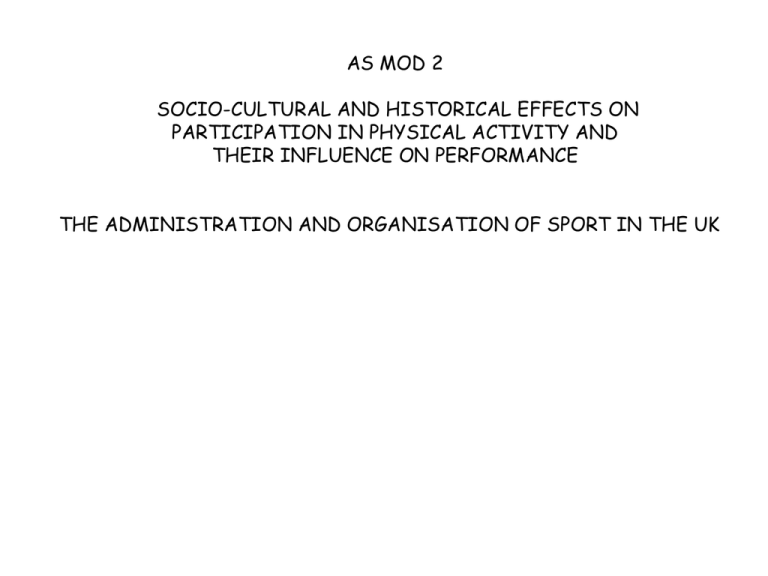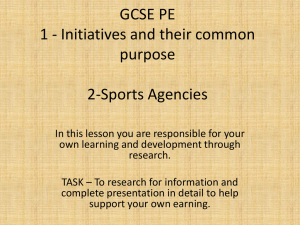
AS MOD 2
SOCIO-CULTURAL AND HISTORICAL EFFECTS ON
PARTICIPATION IN PHYSICAL ACTIVITY AND
THEIR INFLUENCE ON PERFORMANCE
THE ADMINISTRATION AND ORGANISATION OF SPORT IN THE UK
PARTICIPATION PYRAMID
Excellence
Performance
Participation
Foundation
FOUNDATION
Intro to basic sport skills, mostly via physical education programmes in schools
PARTICIPATION Individ participates out of choice, for fun and to develop skills
PERFORMANCE
High club or regional standard; commitment in training and perfecting skills
EXCELLENCE
Elite is the level to which only a few aspire
INTRODUCTION
Mod 2 concentrates on ADMINISTRATION of physical recreation and sport at the
PARTICIPATION or GRASS ROOTS LEVEL
In the UK:
For majority of 20th C, little legislation given to sport by UK Gov’s
Sport developed from GRASS ROOTS level up, not from Gov policy
Structure for delivering and administrating sport are very complex, having evolved
over a century and a half in an “ad hoc” fashion
DECENTRALIZED system, allowing regions to adapt policies suitable to their own
needs, but has led to similar and competing roles
ADMINISTRATION OF SPORT AND ACTIVE RECREATION IN THE UK
4 main sectors
1.)
Local Government (public sector provision)
2.)
Education (schools, FE, and HE)
3.)
Voluntary Sector (clubs and NGBs)
4.)
Private Sector
KEY ORGANISATIONS INVOLVED IN SPORT IN ENGLAND
National (Gov):
National (non Gov):
- Dept of Culture, Media and Sport (DCMS)
- Dept for Education and Skills (DfES – funding PE and School Sport)
- UK Sport
- UK Sport Institutes
- Sport England
- English Institute of Sport (EIS)
- NGBs
- National sports organisations inc: Youth Sports Trust (YST), Central Council
of physical Recreation (CCPR), Sports Leaders UK, SportsCoach UK
Regional
- Sport England’s Regional Offices
- Regional cultural consortia (brings together activities of DCMS in regions)
- 9 Regional sports boards (RSB) brings together key regional sports stakeholders
- Gov offices (each has DCMS rep)
- Regional Federations of Sport and Recreation bring together NGB reps and other
organizations at regional/country level
- County partnerships
- NGBs at regional and county level
Local
- LOCAL AUTHORITIES
- NGB at local level
- LOCAL SPORTS COUNCILS
- LOCAL SPORTS CLUBS AND ASSOCIATIONS
- PRIVATE HEALTH AND FITNESS CLUBS
- Further and higher education institutions/schools
IMPORTANT POINTS
1.)
Central Gov, through DCMS, responsible for overall devel of sports policy in England
2.)
4 sports councils – Sport England
- Sport Scotland
- Sports Council for Wales
- Sports Council for Northern Ireland
Form link between gov and sports organizations and distribute lottery and gov funding
3.)
National sports organizations are independent of gov e.g British Sports Trust
4.)
Each sport has at least 1 NGB which oversees rules and competitions. Also delivers funds for
coaches, officials and administrators
5.)
Local Authorities are biggest key providers for sport and rec. They can choose what level of
provision they provide. They work in partnership with voluntary and private sectors providing
sport through Sport Development Officers (SDO’s)
6.)
Voluntary run local sports clubs (affiliated to NGB’s) provide most opportunities at
participation level
FUNDING FOR SPORT AND PHYSICAL ACTIVITY
Various sources:
Public Sector
Government
Local Authorities
Voluntary Sector
Unpaid contributions
Private Sector
Television
Sponsorship
LOTTERY FUNDING
Has significantly increased amount of funding for sport combined with increases in exchequer/gov
funding and TV rights
VOLUNTARY SECTOR
Holds up GRASS ROOTS delivery with 110,000 community amateur sports clubs run by 1.5 million
volunteers
PRIVATE SECTOR
Grown dramatically with 3 million people belonging to private fitness clubs compared to 2.4 million
members of PUBLIC health and fitness centres
QUESTION:
1.)
Is this an alternative to Public provision in the future?
2.)
What about the people who clearly could not afford high membership fees
charged by private clubs
3.)
Should lottery money be spent on sport? Justify?
REASONS FOR NATIONAL GOVERNMENT INVOLVEMENT IN SPORT (MINE SPILL)
Why?
M
MILITARY. Healthy pop is more likely to be able to defend the country
I
INDIVIDUALIZING. Individ becomes happier/successful person through sport
N
NATIONAL PRESTIGE. “feel good” factor a nation experiences through international sport
success
E
ECONOMIC. Sport is big business, gov receives more revenue from sport than it gives it
S
SOCIALIZING or NATIONALIZING. Values learnt from sport participation produce valuable
who respect social order and are loyal/patriotic
P
POLITICAL INDOCTRINATION. Using sport to influence the beliefs of a nation e.g 1936
Olympics, Hitler used it as showcase for Aryan superiority
I
INTERNATIONAL GOODWILL. Countries come together through sport opening avenues of
communication that may be lost politically
L
LABOUR FUNCTION. Using sport to create healthy/productive workers e.g military drill in 19th
C state schools
L
LEGISLATIVE. Laws are passed r.e sport e.g safety issues, spectator violence, sport policies
KEY GOVERNMENT POLICIES IMPACTING ON SPORT AND PHYSICAL ACTIVITY (FAGESH)
F
FACILITIES - Provided by LA’s
- Gov introduced protection to stop unnecessary sale of school playing fields
A
A SPORTING FUTURE FOR ALL (2001) – Gov’s vision for sport in 20th C highlights importance of coordinating sport between schools, local clubs and organizations
G
GAME PLAN (2002) – The implementation of “A Sporting Future for All”. It recommended:
- developing the UK’s sport and Physical activity culture
- enhancing International success
- improving approach to mega events and major sport facilities
- improving organizational structures to deliver sport and physical
activity
E EQUITY
- Gov wants opportunity for all to participate in sport, regardless of age, sex, race or
disability
- Social inclusion for under-represented groups:
children in schools
people with disabilities/spec needs
ethnic minorities
women
S SPORT: RAISING THE GAME (1995)
H HEALTH
- Gov’s overall objective is to increase participation levels so society achieves minimum levels
of physical activity to maintain health
- Key aim is to ensure young people continue to be active beyond school leaving age
LOCAL AUTHORITIES
- Gov believes CULTURE, SPORT and TOURISM can improve people’s QUALITY of LIFE
- Gov believes investment in sport is a necessity for LOCAL AUTHORITIES (LA’s)
- LA’s are largest providers of sporting opportunities encouraging people to lead healthy, active
lifestyles, esp young people
- LEISURE SERVICES (sport, arts, museums, parks and recreation) have to use BEST VALUE process
Q.)
What is Best Value?
Q.)
What is its purpose?
A key Gov policy requiring LA’s to consider the best value for money
they can provide as well as the value of the experiences they offer
- To provide strategic direction for provision of sport in region
- It identifies key issues and sets a framework for managing performance
SPORTS DEVELOPMENT
- Process that LA’s are involved in to enhance opportunities for all people of all ages, interests and
level of ability to take part, get better and excel in their chosen sport
- It is:
relevant to local needs
enables others to provide opportunities
partnership-based
raises awareness that equal opps requires enormous effort
- Key organizations involved that influence LA’s are:
Key messages are:
Gov Strategy Unit
DCMS
Sport England
- important health benefits of active participation in sport
- strong “feel good” factor brought by sporting success
- importance of young people taking part in sport, in and out of school, and
maintaining this participation
positive impact sport has on local communities
BEST VALUE
- Along with Sport England, LA’s have worked to improve sport through
- facility development
- raising standards of management
- sports development initiatives
- events
- campaigns
Q.)
What is Best Value about?
- finding out what people want and expect
- setting standards that match expectations
- delivering services to these standards
- measuring and demonstrating successful service delivery
- reviewing expectations, standards, delivery and success
Q.)
Why invest in sport?
- Improved health
- Reduced crime
- Economic regeneration
- Improved employment opportunities
Q.)
What does sport have the potential to do for a community?
- Encourage those who feel excluded from society to access a wide range of services and
facilities, creating a sense of purpose, bringing people together and providing common identity
- Contribute to personal development through enhancement of new skills, social interaction and
well-being
- Deter people from anti-social behaviour, allowing them to channel and challenge offending
behaviour in a non-threatening way
- Improve health by keeping people physically active and promoting the health benefits
associated with exercise
- Create employment opportunities, which help to improve the economy
- Advance young people’s development by instilling self-belief and a sense of achievement
Q.)
Imagine you work for a LA, and need to prepare a development plan for sport. What factors
would you need to consider?
- ECONOMIC: wealth of the community
- CULTURAL: local ethnic mix
- GEOGRAPHICAL: is it a rural or urban population
- POLITICAL INFLUENCES: the opinions of the elected council/historical investment in sport
- FACILITIES: from education and private sectors, etc
- AIMS/PLANS OF OTHER GROUPS
Q.)
What does “DUAL-USE” facility mean?
- Where a local school’s facilities could be used by a local community after school, at weekends
and in the school holidays. These facilities usually have a centre manager who co-ordinates use
of it. Costs were shared between authorities.
Q.)
Want are the strengths and weaknesses of it?
STRENGTHS
WEAKNESSES
Community Base
Limited access for public
Links with schools
Image/awareness
Shared costs
Different need for school
and public
Guarranteed usage
LOCAL PROVISION OF LEISURE
Q.) local provision of leisure comes from which 3 areas?
- Public (via LA)
- Private (profit making businesses)
- Voluntary (grass roots of local clubs)
Q.) What are their characteristics?
PUBLIC (eg local leisure
centre)
PRIVATE (eg private
fitness centre)
VOLUNTARY (eg local
netball club)
Run by LA
Privately owned
Run by members
Trading on set
prices/charges according
to pre-set budget
Trading on normal
profit/loss/self-financed
Trading on normal
profit/loss basis
Managed by LA employees
Managed by owners and
their employees
Managed by members
committees
Subsidised by council
Must operate in open
market and make a profit
Financed by members
fees, fundraising,
sponsorship
Funds from membership
fees
Q.) What are the objectives of each sector?
PUBLIC
PRIVATE
VOLUNTARY
Provides service for
local community
Aims to make a profit
for owner
Provides for grass
roots sport
More affordable than
Private sector
Can cater for a more
exclusive and
wealthier clientele
Tries to increase
participation in their
sport
Social impact on
health, employment
and occupying
population in positive
activities
SPORT ENGLAND
What is it?
- Gov funded agency responsible for providing strategic lead for sport in England to deliver Gov’s
objectives
- Distributor of lottery sports fund
What is its role?
-
Strategic lead for sport in England
makes investments through partners
provide advice, support to partners and customers
influence decision makers and public opinion on sport
What are its objectives?
START – increase participation in sport in order to improve health of the nation, esp
priority groups
STAY – retain people in sport and active rec through clubs, sports facilities and coaches,
volunteers and competitive opportunities
SUCCEED – achieve sporting success at every level
ENSURE INTERNAL EFFICIENCY – operate and allocate resources with max
effectiveness
ACTIVE SPORTS PROGRAMME
What is it?
Scheme run by Sport in England based on 4 policies
1.) ACTIVE SCHOOLS
forms foundation
2.) ACTIVE COMMUNITIES
breaks down barriers to participation and considers equity issues
3.) ACTIVE SPORTS
links participation to excellence e.g Millennium Youth Games
4.) WORLD CLASS ENGLAND
operates 4 programmes to develop top performance
Majority of funding comes from Lottery
SPORTSMARK AND ACTIVEMARK
- Awards given to Schools for showing good provision of sport and PE
- Currently being revamped as Gov making investment into PE and school sport and is delivering the national school
sport strategy
PHYSICAL EDUCATION, SCHOOL SPORT AND CLUB LINKS STRATEGY (PESSCLS)
What is it?
- Joint DCMS/DfES initiative
- To enhance the take-up of sporting opportunities of 5 – 16 yr olds to increase the amount
of HIGH QUALITY PE AND SCHOOL SPORT (currently min 2hrs/week) within and beyond
the curriculum
8 components:
Specialist Sports Colleges
School Sport Partnerships:
A cascade of 1 Specialist Sports College, 8 Secondary Schools
and 45 primary Schools
Gifted and Talented:
Aims to improve quality of teaching, coaching and learning and
raise aspirations to improve performance, motivation and selfesteem
QCA Investigation:
The Qualifications and Curriculum Authority investigates impact
of “High quality sport and PE”. Benefits of attendance, better
behaviour, positive attitudes and higher self-esteem
Step into Sport:
Encourages children and young people to lead and volunteer
Professional Development:
Club Links:
Swimming:
PESSCLS cont’d
What could “High quality PE and Sport in Schools” improve?
- Pupil concentration, commitment and self-esteem, leading to higher attendance, better behaviour and attainment
- Fitness levels: reducing obesity and chances of CHD and Diabetes
- Success in International competition, ensuring talented young people have a pathway to elite sport
NATIONAL GOVERNING BODIES
What are they responsible for?
Responsible for its own sport, overseeing competitions and ensuring internationally agreed rules are adhered to.
Affiliated to International Sports Federation eg FA and FIFA
SPORTS LEADERS UK
Provides opportunity and motivation for people to make meaningful contributions to community
Through Sports Leader Awards, people can learn to work with and organise others, motivational, teamwork and
communication skills
The Awards are:
JUNIOR SPORTS LEADER AWARD (14-16 yrs)
Taught in schools within NC for PE at KS 4 to develop organising
activities, planning, communicating and motivating
COMMUNITY SPORTS LEADER AWARD (16+ yrs) Taught in schools, colleges, youth clubs, prisons and sports/leisure
centres
HIGHER SPORTS LEADER AWARD
Builds on CSLA training people to lead community groups such as
older people, people with disabilities and primary school children
BASIC EXPEDITION LEADER AWARD
What core values might these Awards develop?
Leadership
Encouraging volunteering in communities
Skills for life
Reducing youth crime
Stepping stone to employment
Supporting more active, healthier communities
YOUTH SPORTS TRUST
It supports education and development of young people via PE and sport so they can experience and enjoy it
Has developed a series of linked and progressive schemes:
TOP programmes (18 months – 18 yrs)
Inclusion of young disabled people
Encouraging more teenage girls to participate
Tackling social exclusion within primary schools through playground development
Supporting Gifted and Talented young sports people








